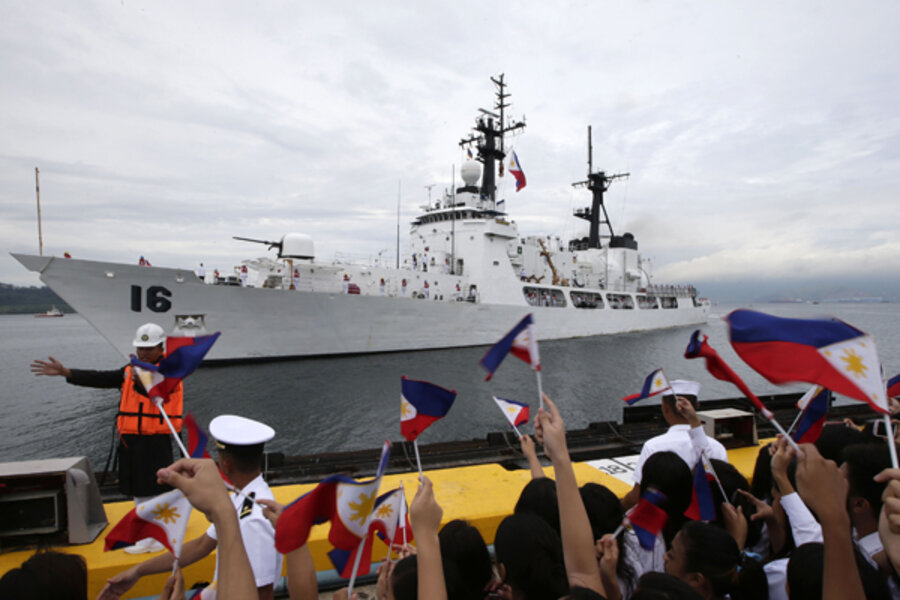Philippines warship: Old US Coast Guard cutter gets second life
Loading...
| Subic, Philippines
The Philippines on Tuesday celebrated the arrival of a decommissioned US Coast Guard cutter that will become its meager navy's second largest ship as it attempts to counter rival Chinese territorial claims in potentially oil-rich offshore seas.
President Benigno Aquino III saluted as the 3,250-ton white cutter, renamed Philippine navy frigate BRP Ramon Alcaraz, docked at a wharf in Subic Bay freeport northwest of Manila. A part of the former US naval base will soon be turned into a Philippine military hub after the government approved a plan to shift its assets closer to the disputed islands in the South China Sea.
The ships are no match for the vastly superior Chinese navy, but both Philippine and US officials have agreed to boost the country's military to make it more credible and shake its image of being one of the region's weakest. Washington is a defense treaty ally of the Philippines and is obligated to help fend off an external attack.
The Alcaraz is the Philippine navy's second largest vessel after another decommissioned Coast Guard cutter that was donated by Washington in 2011.
That ship, the 3,390-ton frigate BRP Gregorio del Pilar, has patrolled disputed waters and became entangled last year in a standoff with Chinese vessels at Scarborough Shoal, a sprawling fishing ground more than 160 miles west of Subic that came under Beijing's control after Philippine vessels withdrew.
Philippine navy chief Vice Adm. Jose Luis Alano said the Alcaraz will also soon be deployed to patrol disputed waters. He said the Philippines is considering adding a third former US Coast Guard cutter to its fleet.
A military brass band played nationalist songs and a few hundred students waved small Philippine flags in Tuesday's ceremony. Loud 21-cannon fire thundered in the background.
"It will further intensify our patrolling of the Philippines' exclusive economic zone and our capability to quell any threat and bad elements, respond to search and rescue operations and take care of our marine resources," Aquino told a crowd that included US Ambassador Harry Thomas.
Also Tuesday, Japan unveiled its largest warship at a naval base in Yokohama. Japan has been locked in a separate and potentially volatile territorial dispute with China over small islands controlled by Tokyo in the East China Sea.
The developments point at an arms race by China's neighbors that have been alarmed by Beijing's assertiveness in claiming vast waters and backing those claims by deploying new maritime forces and refurbished vessels. Its claims in the South China Sea overlap with the 220-mile exclusive economic zones of the Philippines, Vietnam and other claimants.
In the Philippine-claimed Spratly Islands, a confidential military report said 74 foreign vessels were spotted in a six-day surveillance period early last month, including 61 from China and 10 from Vietnam.
The report, obtained by The Associated Press, said Beijing's surveillance patrols are now more organized in the disputed waters off the western Philippines, with the same Chinese vessels being rotated to guard both Scarborough Shoal and the Second Thomas Shoal farther south. Mischief Reef, a vast area occupied by China in 1995, now serves as a "central base" and "crucial outpost for replenishing China's naval and maritime assets in the disputed area," it said.
China has also deployed its own coast guard cutters in disputed waters to complement maritime surveillance and fishery enforcement ships. The action "demonstrates China's resolve to consolidate its self-acclaimed indisputable sovereignty in the South China Sea," the report said.
The Philippines antagonized China when it filed an arbitration case with a UN tribunal handling maritime disputes. China has preferred to settle the disputes bilaterally, but the Philippines and Vietnam, which is also engulfed in a rift with China over the Paracel Islands, want to involve the 10-member Association of Southeast Asian Nations.
Last week, China's president adopted a more reconciliatory tone, saying Beijing will continue to guard its sovereignty claims but also wants to open some disputed areas to joint economic development. The Philippines says it is open to the idea but it must conform with Philippine laws — a potential deal-breaker.







